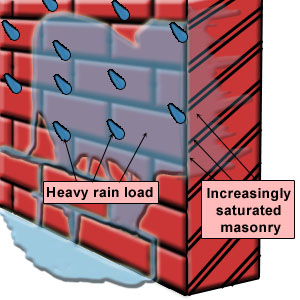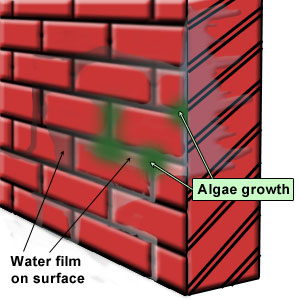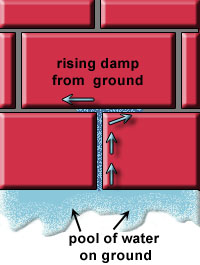Case 1
- Introduction
- Causes of Defects
- Good Practices
- Standards
- Maintenance and Diagnostics
- Remedial
- Similar Cases
- References
Cause of Defects
Possible sources of water:
a) Rainwater



Masonry usually absorbs all driving rain at the beginning. If the driving rain is very heavy or continues a long time, the rate of absorption can be lower than the rain load. Thus a film of water forms on the surface (Figure 1 & 2).
b) Humidity
Humidity indoors is usually higher than outdoors. When the indoor air is cooled, the relative humidty increases and condensation may occur from the inside.
c) Construction moisture
Large amount of water may be present after the building is completed especially with bricks and rendering.
d) Rising damp
Movement of water up the wall from ground by capillary action may cause dampness to the brick surface (Figure 3).
The presence of any amount of moisture may be a conducive platform for fungi to grow and thrive.
Consequences
The fungi growth will spread to a bigger area if left unchecked.
Algae Growth
Algae growth has been characterised by two (a) factors attributed to the environment (b) factors attributed to the building envelope. Environmental factors consist of climate, thermal amplitude, precipitation, hygrometry (humidity), distance from the sea and presence/absence of vegetation. Precipitation and hygrometry directly affect the availability of water on to building facades, which is widely known as one of the key requirements for algae growth. In Singapore, the high humidity and precipitation result in buildings experiencing high amounts of water contact throughout the year. The closeness of the building to the sea can also result in higher atmospheric humidity, leading to a greater chance of algae growth. Building related factors affecting algae growth are high alkalinity (e.g. fresh concrete, high in alkaline helps algae to grow), excess surface moisture, windborne transport (orientation), and rain streaks that carry the algae spores down a façade.
Left unchecked, algae will grow on surfaces to create an aesthetically subjective discolouration with various shades of green, orange, black or blue. Besides being aesthetically unpleasant, biological growth on facades may also cause deterioration and further weathering to the wall.